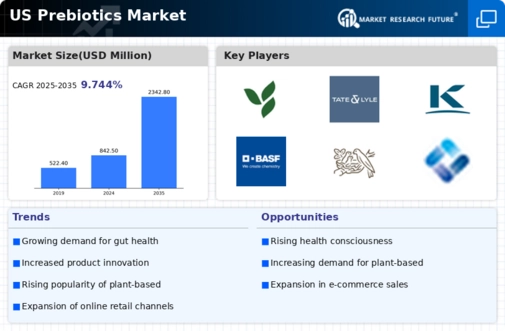Regulatory Support for Health Claims
The prebiotics market is positively impacted by regulatory support for health claims associated with prebiotic ingredients. Regulatory bodies in the US are increasingly recognizing the health benefits of prebiotics, which is encouraging manufacturers to promote their products more effectively. This support is likely to enhance consumer trust and drive sales, as consumers are more inclined to purchase products backed by credible health claims. Recent guidelines have allowed for clearer labeling and marketing of prebiotic products, which could lead to a projected growth of 15% in the prebiotics market over the next five years. As companies navigate these regulations, they are likely to invest in research and development to substantiate health claims, thereby fostering innovation and growth within the market.
Rising Interest in Plant-Based Diets
The prebiotics market is significantly influenced by the rising interest in plant-based diets among consumers. As more individuals adopt vegetarian and vegan lifestyles, the demand for plant-derived prebiotics is expected to grow. Research indicates that plant-based foods are rich in prebiotic fibers, which are essential for maintaining gut health. This shift in dietary preferences is likely to propel the market, as consumers seek natural sources of prebiotics from fruits, vegetables, and whole grains. The plant-based food sector is projected to expand at a CAGR of 10% through 2027, which will likely contribute to the growth of the prebiotics market. Manufacturers are responding by introducing a variety of plant-based prebiotic products, catering to the evolving consumer preferences and dietary trends.
Growing Awareness of Functional Foods
The prebiotics market is benefiting from the growing awareness of functional foods among consumers. Functional foods, which provide health benefits beyond basic nutrition, are gaining traction as individuals seek to enhance their diets with beneficial ingredients. Prebiotics, known for their role in promoting gut health and boosting immunity, are increasingly being incorporated into various food products. Market data suggests that the functional food segment is expected to reach $300 billion by 2025, with prebiotics playing a crucial role in this growth. This trend is prompting food manufacturers to innovate and create new products that highlight the inclusion of prebiotics, thereby expanding their market share. The increasing consumer focus on health and wellness is likely to sustain this momentum in the prebiotics market.
Increasing Demand for Digestive Health Products
The prebiotics market is experiencing a notable surge in demand for products that promote digestive health. Consumers are increasingly aware of the importance of gut health, which is driving the growth of prebiotic supplements and functional foods. According to recent data, the digestive health segment is projected to account for approximately 30% of the overall prebiotics market by 2026. This trend is fueled by a growing population seeking natural solutions to digestive issues, such as bloating and irregularity. As a result, manufacturers are focusing on developing innovative prebiotic formulations that cater to this demand, thereby enhancing their market presence. The increasing inclination towards preventive healthcare is likely to further bolster the prebiotics market, as consumers prioritize products that support their overall well-being.
Expansion of Nutraceuticals and Dietary Supplements
The prebiotics market is witnessing a significant expansion in the nutraceuticals and dietary supplements sector. As consumers become more health-conscious, there is a growing preference for supplements that support gut health and overall wellness. The nutraceuticals market is projected to grow at a CAGR of 8% from 2025 to 2030, indicating a robust demand for prebiotic supplements. This growth is driven by the increasing prevalence of digestive disorders and the rising awareness of the benefits of prebiotics. Manufacturers are capitalizing on this trend by developing a diverse range of prebiotic supplements, including powders, capsules, and functional beverages. The expansion of this sector is likely to enhance the visibility and accessibility of prebiotics, further propelling the prebiotics market.



















Leave a Comment